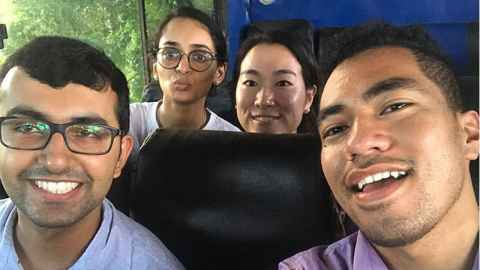Externship testimonial
Our student, Amosa Lene shares his experience attending a medical camp in Fiji with Sathya Sai International (SAI).

"For my second optometry clinical placement, I was given the opportunity to attend a medical camp with an organisation called Sathya Sai International (SAI). Every year, this international organisation provides various health services to communities in regional areas that are unable to access care. Their volunteers include doctors, optometrists, physiotherapists, dentists, pharmacists and students, among others who help cook and clean for the camp and assist the clinicians.
"The medical camp runs over six days and SAI takes the group to various villages across Fiji, sometimes travelling as far as two hours from the main city centres. These villages have poor access to health services and so they are always incredibly grateful when they see overseas help coming to them.
"I remember my supervisor briefing us the night before about all the things that we needed to do and how they were to be done. These tasks included:
- Visual acuities with tumbling E charts
- Binocular refractions with flippers and trial lens sets
- Anterior and posterior health with an ophthalmoscope
- Cycloplegic refractions on indication
- Dilations on indication
- Prescribing ready-readers
- Prescribing any relevant medications, mostly limited to Rexacrom (mast cell stabiliser), poly-tears, chloramphenicol ointment and drops
"When I learned that we were limited to only an ophthalmoscope for rough anterior and posterior health examinations, I remember thinking that I probably should have taken my pan retinal lens for greater magnification of any anterior health abnormalities.
Since the externship, I am...much more confident in being able to
identify and differentiate nuclear sclerosis and posterior subcapsular
cataract.
"I learned so much while on this trip. One of my biggest achievements was becoming more confident in doing low-vision style refractions. A lot of the patients that we saw were elderly and this this style of refracting sped things up.
"Since the externship, I am also much more confident in being able to identify and differentiate nuclear sclerosis and posterior subcapsular cataract. Posterior subcapsular cataracts can appear in a similar way to anterior subcapsular cataract. Cortical cataracts are best seen upon dilation of the patient.
"The posterior health was particularly challenging as I had not had much experience using an ophthalmoscope to do a posterior examination. But like the anterior health, I quickly became confident in:
- Bringing the optic nerve head in to focus
- Following the arcades
- Identifying C/D ratio asymmetry
- Identifying posterior segment anomalies
- Seeing haemorrhaging and exudates
- Seeing posterior vitreous detachment
"Being a part of this medical camp truly made me realise how important optometry is, particularly in community areas where there is poor access to health care. There is an immense gaping hole that needs to be filled, especially in countries such as Fiji, and I hope to one day return to the islands help with this."